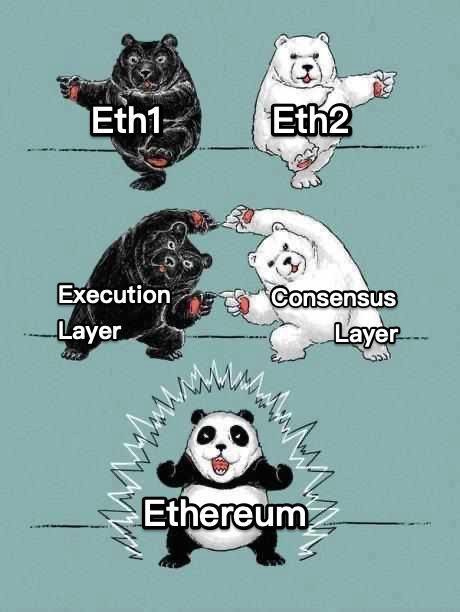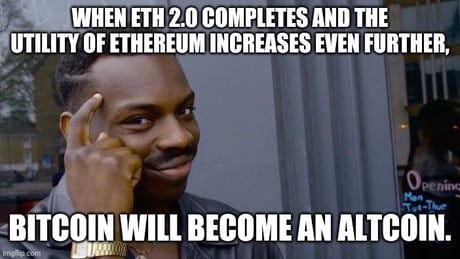The End of Mining: The Ethereum Proof-of-Stake Merge
ETH is moving from PoW to PoS consensus mechanism to confirm transaction blocks, a process commonly known as “The Merge”.
That sound you hear is the world’s largest blockchain mining network shutting down its power-hungry computing machines. In the most significant blockchain upgrade in history, the Ethereum network, host to 74% of all decentralized applications, is moving from a proof-of-work (PoW) to a proof-of-stake (PoS) consensus mechanism to confirm transaction blocks, a process commonly known as “The Merge”.
A palpable sense of excitement and anticipation is pulsing through the Ethereum developer community as this important milestone on the Ethereum roadmap fast approaches. The leading smart contracts with business logic platform quickly outgrew the PoW blockchain and will soon be unsustainable. The annual energy consumption of Ethereum has soared with the rise of decentralized finance apps to reach 44.5 TWh per year, about the same as major financial centers like Hong Kong and Singapore.
In 2018, the Ethereum 2.0 proposal solved the Scalability Trilemma and conceived the future blockchain. The two major upgrades of ETH 2.0, proof-of-stake consensus and sharding, promise to deliver fast transaction times with low network costs without sacrificing scalability, security, or decentralization. The Merge is Phase 0 of the rollout of the Ethereum 2.0 improvements this year.
Phase 0 (The Merge) — Proof-of-Stake Beacon Chain, a more efficient and fair transaction block consensus mechanism
Phase 1 — Sharding to increase scalability and throughput by a factor of hundreds
Phase 2 — DApp migration to ETH 2.0 shard chains
In Phase 0, The Merge will make the blockchain network more environmentally sustainable, secure, and scalable (the 3S’s). A more elegant PoS algorithm that can run from your Raspberry Pi and other portable computing devices will replace monstrously power-hungry mining machines with high hardware and electricity costs.
A Giant Step, Not a Leap
Since 2018, many new blockchains have launched and seemingly leapfrogged Ethereum in implementing some or all of these features, along with zero-knowledge proofs and other Layer 1 and Layer 2 scalability solutions.
The multi-year rollout approach of Ethereum, in contrast, reflects the tens of billions of dollars in transactions on the popular, rapidly growing blockchain. The difference is like comparing a $2 million rocket test launch with dummy astronauts to that of a $100 million rocket with real astronauts on board.
Prudently, Ethereum has gradually been transitioning to the new PoS consensus layer. In December 2020, the Beacon Chain went live as a fully independent PoS consensus layer running parallel to the Ethereum mainnet. Ahead of the complete transition in Q2 2022, the Kiln Testnet Merge went live on March 15.

‘The Merge’ will replace PoW and the temporary split solution with the more energy-efficient PoS consensus layer, the Beacon Chain. Transaction blocks will no longer be confirmed by solving computationally intensive puzzles. Each validator node will stake 32 $ETH and receive rewards for securely confirming blocks. If validators confirm incorrect information sent by malicious actors that cannot be confirmed, the network will reduce the shared reward amount.
After The Merge, Ethereum expects to be the most used, most powerful, and energy-efficient blockchain. The energy used to confirm blocks on the Ethereum chain is expected to fall by 99.5%. The handover is on track to occur without transaction loss or downtime.
What the Merge Will Not Do
The upgrade will have no direct impact on the close to 3,000 DApps running on the Ethereum blockchain, representing 74% of the DApp universe. Alas, it also means Ethereum’s high transaction fees will not be lowered — yet.
The primary purpose of The Merge is to upgrade the consensus mechanism with the significantly more energy-efficient PoS consensus mechanism and deliver the 3S’s.

So let’s bust a few myths circulating ahead of The Merge.
❌ The merge will lower gas fees — This upgrade will not lower your DeFi, NFT, and other transaction costs on the Ethereum chain, as it is only related to the consensus mechanism securing the network. The Merge does prepare the path for the future upgrade to sharding, which will lower gas fees.
❌ Stakers require 32 $ETH to participate in the new PoS protocol — Each full node will be required to stake 32 $ETH to operate in the PoS network. Optionally, validators can participate in validator pools and commit a lesser amount to participate in running a validator node through services such as RockerPool.
❌ A new ETH2 token will be minted — The upgraded Ethereum network is not a new network, nor is there a new token. The Ethereum Foundation is moving away from the ‘Eth1’ and ‘Eth2’ terminology to avoid confusion. For more, see The great renaming: What happened to Eth2?
‘The Triple Halvening’ — Towards a Deflationary Currency
The Ethereum proof-of-stake merge will most likely cause a significant change in the supply of $ETH in the short term.
Once the merge takes place, the issuance rate of Ethereum will be based on the amount of $ETH actively staked. Consequently, an immediate $ETH issuance reduction of about 90%, from the current annual issue of about 4.3% to 0.03–0.04%, of the total $ETH supply is expected — halving at about 3 times the Bitcoin rate of every 4 years.
A second deflationary headwind is the implementation, in August 2021, of EIP-1559 — replacing user bidding with an automated bidding system and the burning of all transaction fees, thereby reducing the $ETH supply.
While it should be business as usual for decentralized applications running on the Ethereum blockchain, DApps currently running on Ethereum and new DApps planning to do so can try out the PoS version in the testnet during the ETHGlobal Scaling Ethereum hackathon (April 16 — May 14).
Node operators, application developers, and infrastructure providers are currently trying out the Kiln Testnet Merge with no major issues reported. You would not send a rocket into space without a flight test, so why not give the upgraded Ethereum a few spins before it goes live.
The core Ethereum developer community behind the Kiln Testnet Merge says the migration to mainnet is on target for June, given any unknown unknowns. With transaction process rewards no longer in the hands of the most powerful miners, a fairer consensus environment is already emerging. The testnet currently has over 300,000 validators, 37% of which are home validators.









